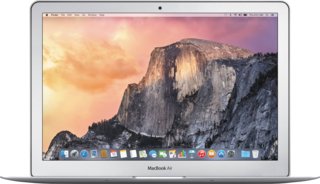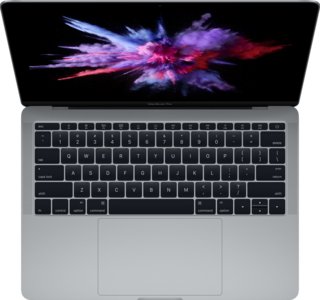Apple MacBook Air (2015) 13" vs Apple MacBook Pro (2016) 13"
Join us as we explore a balanced comparison between two of Apple's prime offerings - the MacBook Air (2015) 13" and the MacBook Pro (2016) 13". We'll break down their features and performance in easy, relatable terms. From their stylish designs to their speedy performance, we dissect it all. Whether you're a graphic design professional in need of a performance powerhouse, or a student seeking a lightweight academic ally, we've got insights for you. We'll impartially highlight the strengths and weaknesses of each model, providing you with important details on durability and task suitability. By simplifying the technical specifics of each laptop, we aim to help you make an informed decision that aligns perfectly with your needs. Stick around as we navigate this tech comparison crafted just for you!
System and application performance
Performance in popular 3D games
Viewing angle, color accuracy...
Ports, webcam and other interfaces
Potential battery life
Materials, durability and portability
Design Comparison
Size Comparison
When comparing the Apple MacBook Air (2015) 13" and the Apple MacBook Pro (2016) 13" in terms of design elements that enhance user experience, we need to consider how these designs impact practical usability and aesthetic appeal for different user groups such as students and professionals.
Ergonomics
- Both laptops are lightweight at about 3 pounds each, making them easy to carry. The MacBook Pro (2016) is a bit smaller and thinner than the MacBook Air (2015), making it more portable without sacrificing screen size. The backlit keyboards on both models provide convenience for working in low-light environments, appealing to users who prioritize ergonomics during long typing sessions.
Materials and Build Quality
- Apple's aluminum unibody construction provides durability and a premium appearance for its laptops. The MacBook Pro (2016) sports a more modern look than the MacBook Air (2015) due to its slightly sleeker design and thinner display bezels.
Portability
- The MacBook Pro (2016) is lighter but still more compact because of its slimmer design and smaller size. The MacBook Pro (2016) features USB Type-C ports that provide users with advanced connectivity options for integrating their devices more efficiently.
Unique Design Features
- The MacBook Air (2015) features traditional USB 3.0 ports, while the MacBook Pro (2016) comes with Thunderbolt ports to accommodate varying user connectivity preferences.
- Both laptops come equipped with stereo speakers, audio jacks, front cameras, and multiple microphones to elevate your multimedia experiences.
Practical Usability
- Students may find the MacBook Pro (2016) convenient to carry around for classes, while professionals might value its sleek design and cutting-edge connectivity features.
- Users who prefer more space between keys may find the wider frame of the MacBook Air (2015) enhances their typing experience.
In summary, both laptops offer Apple's well-known sturdy construction and user-friendly design features but cater to specific user preferences. Buyers looking for a mix of portability and power might prefer the slim MacBook Pro (2016), ideal for tasks needing up-to-date connectivity options. Conversely, individuals who appreciate a classic design with legacy ports may opt for the dependable MacBook Air (2015).
Screen Comparison
| Apple MacBook Air (2015) 13" | Apple MacBook Pro (2016) 13" | |
|---|---|---|
| Refresh Rate | 60 hz | 60 hz |
| Resolution | HD | QHD |
| Screen Size | 13.3" | 13" |
When you look at the screens of the Apple MacBook Air (2015) 13" and the Apple MacBook Pro (2016) 13", various factors influence your viewing experience, particularly when gaming, designing, or engaging in other activities.
Screen Size:
- MacBook Air (2015): 13.3 inches
- MacBook Pro (2016): 13.3 inches
Both laptops feature the same screen size, offering a compact yet comfortable viewing area for various tasks. The 13.3-inch display strikes a balance between portability and usability, ideal for on-the-go use without sacrificing screen real estate.
Screen Resolution:
- MacBook Air (2015): 1440 x 900 px
- MacBook Pro (2016): 2560 x 1440 px
The MacBook Pro's superior resolution provides clearer images and extra screen real estate compared to the MacBook Air, making it ideal for activities like gaming or graphic design projects that demand sharp detail and precision.
Pixel Density:
- MacBook Air (2015): 127 ppi
- MacBook Pro (2016): 227 ppi
The MacBook Pro's higher pixel density improves image and text clarity on the screen, enhancing your gaming experience with sharper visuals and better rendering of intricate graphics.
Display Technology:
- Both laptops: IPS, LCD, LED-backlit
Both laptops come equipped with IPS technology, providing top-notch color accuracy and a broad viewing range. This is particularly advantageous for graphic design work that demands exact color representation and for immersive gaming experiences with vivid visuals from various perspectives, free from any distortions.
Brightness:
- MacBook Pro (2016): 500 nits
The higher brightness level of the MacBook Pro is beneficial for users who often work or play games in brightly lit environments or outdoors. This feature enhances visibility and improves the overall gaming experience, especially for gaming enthusiasts who enjoy playing in different lighting conditions.
Refresh Rate:
- Both laptops: 60 Hz
These laptops come with a standard 60 Hz refresh rate, ensuring smooth screen transitions whether you're gaming or watching videos. While competitive gamers may prefer a higher refresh rate, these laptops provide a decent speed that is suitable for casual gamers and everyday users.
For those who value superior display quality for tasks like professional graphic design or gaming, the MacBook Pro (2016) is the top choice, offering sharper images and detailed visuals. However, if portability and decent display performance at a lower cost are your priorities, the MacBook Air (2015) is a solid alternative.
Hardware Comparison
| Apple MacBook Air (2015) 13" | Apple MacBook Pro (2016) 13" | |
|---|---|---|
| RAM | 8GB | 16GB |
| Storage Size | 512GB | 1000GB |
Comparing the hardware aspects of the Apple MacBook Air (2015) 13" and the Apple MacBook Pro (2016) 13" reveals crucial components that impact performance across different applications. Let's explore these details to assist you in making a well-informed decision:
CPU:
- MacBook Air (2015): Equipped with a dual-core Intel Core i5 processor clocked at 2 GHz base speed and capable of turbo boosting up to 3.2GHz, it ensures efficient power consumption with its 14nm semiconductor size.
- MacBook Pro (2016): The MacBook Pro features a dual-core Intel Core i5 processor, clocked at 2 GHz with a turbo clock speed of 3.3GHz, providing enhanced performance compared to the MacBook Air.
Performance Impact: The MacBook Pro's faster clock speed and enhanced architecture enable it to excel in resource-intensive tasks, such as video editing or running demanding software, setting it apart from the MacBook Air.
GPU:
- MacBook Air (2015): Includes Intel HD Graphics 6000.
- MacBook Pro (2016): Equipped with Integrated Intel Iris Graphics 540.
Performance Impact: The MacBook Pro's Intel Iris Graphics 540 outperforms the Intel HD Graphics 6000 in the MacBook Air, enabling smoother handling of graphic-intensive tasks like gaming or video editing.
RAM:
- MacBook Air (2015): Features 8GB of RAM clocked at 1600 MHz.
- MacBook Pro (2016): Provides 16GB of RAM operating at a speed of 2133 MHz, doubling the previous capacity.
Performance Impact: With its expanded RAM capacity and improved speed, the MacBook Pro offers seamless multitasking and quicker data retrieval, boosting system performance in comparison to the MacBook Air. This is particularly beneficial when dealing with substantial files or running various applications concurrently.
Internal Storage:
- MacBook Air (2015): Provides 512GB of flash storage.
- MacBook Pro (2016) offers a spacious internal storage of 1000GB.
Performance Impact: The increased storage capacity in the MacBook Pro enables users to store larger files without sacrificing system performance, which is particularly advantageous for those working with vast amounts of multimedia content or resource-intensive software applications.
Both the MacBook Pro (2016) and the MacBook Air (2015) offer solid performance, but they cater to different needs:
MacBook Pro (2016):
- Better Performance: Faster CPU and GPU.
- Higher RAM Capacity: Handles more applications simultaneously.
- More Storage: Ideal for demanding tasks like video editing and gaming.
MacBook Air (2015):
- Budget-Friendly: Great for everyday computing without breaking the bank.
- Reliable for Basic Tasks: Perfect for web browsing, document editing, and streaming.
Key Considerations:
- If you need power for heavy multitasking, graphics-intensive work, or large storage capacity, go with the MacBook Pro.
- For simpler tasks and cost savings, the MacBook Air is a dependable choice.
Battery Comparison
| Apple MacBook Air (2015) 13" | Apple MacBook Pro (2016) 13" | |
|---|---|---|
| Battery Life | 14 hours | 10 hours |
When it comes to comparing the battery performance of the Apple MacBook Air (2015) 13" and the Apple MacBook Pro (2016) 13", there are some notable differences to consider:
Apple MacBook Air (2015) 13":
- Battery Life: The MacBook Air offers up to 14 hours of battery life, supporting extended productivity with less need for frequent recharging.
- Sleep And Charge USB Ports: Charge your devices while the laptop is in sleep mode, providing added convenience and flexibility to your workflow.
- The MagSafe power adapter provides additional safety as it easily detaches from the laptop in the event of accidental tugs or pulls, minimizing the chance of damage.
Apple MacBook Pro (2016) 13":
- Battery Life: The MacBook Pro offers up to 10 hours of battery life, slightly less than the MacBook Air.
The MacBook Air surpasses the MacBook Pro (2016) in battery life, providing users with more time for work or entertainment without interruptions. Moreover, the MacBook Air includes convenient features such as Sleep and Charge USB ports and the MagSafe power adapter to enhance user experience.
Both laptops cater to different needs and preferences. If extended battery life ranks high on your list of priorities, consider the MacBook Air. On the flip side, if you prioritize processing power or display quality over prolonged battery usage, the MacBook Pro might align better with your needs.
Verdict
Why Apple MacBook Air (2015) 13"?
- Budget-Friendly option for everyday computing needs without compromising on quality.
- Longer battery life of up to 14 hours, ideal for extended productivity sessions.
- Lightweight and portable design making it easier to carry around for students or on-the-go professionals.
Why ?
- Enhanced performance with faster CPU and GPU.
- Higher RAM capacity for seamless multitasking and quicker data retrieval.
- More storage space suitable for demanding tasks like video editing and gaming.
Similar comparisons
- Apple MacBook Air (2015) 13" vs Apple MacBook Pro (2015) 13"
- Apple MacBook Air (2015) 13" vs Apple MacBook Air (2017) 13.3" Intel Core i5 128GB
- Apple MacBook Air (2015) 11" vs Apple MacBook Pro (2015) 13"
- Apple MacBook (2016) vs HP Omen 15-AX033DX 15.6" Intel Core i7-6700HQ
- Apple MacBook (2016) vs Lenovo Yoga 900 Business Edition 13.3" Intel Core i7-6560U

